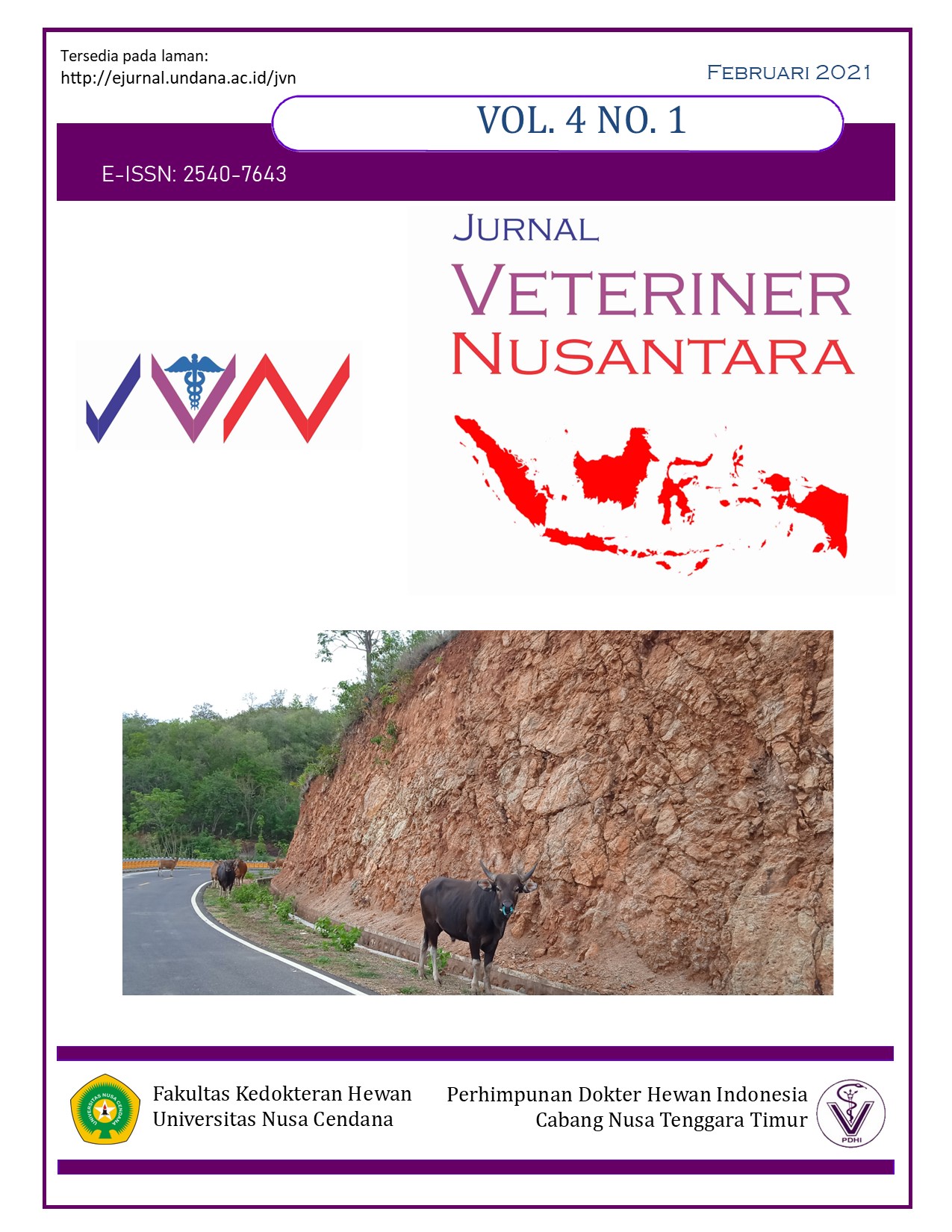Ragam Jenis Dan Kelimpahan Lalat Pada Peternakan Sapi Di Kupang
Abstract
East Nusa Tenggara (NTT) is one of the provincial livestock producer and breeder sector has also become one of the sectors that support the communities in the province of East Nusa Tenggara. In support of the program of cattle to be free of the disease, efforts to improve the beef cattle population is affected by several factors such as enclosure management and disease prevention. Diseases that can reduce productivity in cattle caused by bacteria, viruses, endoparasites and ectoparasites. One of the ectoparasites that act as vectors of disease that often occurs in cattle are flies. This study aims to look at the Variety type and abundance Flies On Cattle in Kupang located in two studies namely Cattle Farmers Group Noetnana, Village Fatukoa, District Maulafa, Kupang (farm I) and Cage Cattle SMK PP Kupang State (farm II). Fly collection is done by using two methods: the method of sweeping and manual methods.Flies sample processing is done by piercing flies (pinning) using pinning needles on one side of the thorax slightly to the right of the center line.The diversity of types of flies analyzed using the formula of relative abundance. The diversity of types of flies obtained during the research was Haematobia sp. Hippobosca sp. Stomoxys calcitrans, Musca domestica, and Tabanus sp. Factors that contributed to support the amount of diversity of types of flies are carrying appropriate for the survival of various types of flies in these locations such as temperature, humidity, food and breeding grounds. The total number of flies were obtained during the study was 3308 flies.
Downloads
References
Brazil SM, Dayton CS, Allen LS. 2007. Detection of pathogen DNA from filth flies (Diptera: Muscidae) using filter paper spot cards. J Agric Urban Entomol. 24 (1) 13-18.
Chin HC, Ahmad NW, Kian CW, Kurahashi H, Jeffrey J, Kiang HS, Omar B. 2010. A study of cow dung Diptera in Sentul Timur, Kuala Lumpur, Malaysia. J Trop Med Parasitol. 33(2):53-61.
Cupp EW, Cupp MS, Ribeiro JM, Kunz SE. 1998. Blood-feeding strategy of Haematobia irritans (Diptera:Muscidae). J Med Entomol.
El-Hassan GMMA, Badrawy HBM, Mohammad AK, Fadl HH. 2010. Cladistic analysis of Egyptian horse flies (Diptera: Tabanidae) based on morphological data. Egypt Acad J Biolog Sci. 3(2):51-62.
Gillespie BE, Owens WE, Nickerson SC, Oliver SP. 1999. Deoxyribonucleic acid fingerprinting of Staphylococcus aureus from heifer mammary secretions from horn flies. J Dairy Sci.
Hadi UK, Koesharto FX. 2006. Lalat. Dalam: Hama Permukiman Indonesia: Pengenalan, Biologi, dan Pengendalian. Sigit SH, editor. Hadi UK, editor. Bogor (ID): Unit Kajian Pengendalian Hama Permukiman Fakultas Kedokteran Hewan IPB
Hadi UK, Sigit SH. 2006. Hama dan Permukiman Indonesia: Pengenalan, Biologi dan Pengendalian. Bogor (ID): IPB Pr.
Hadi UK, Soviana S, Tatty S. 2011. Ragam jenis nyamuk di sekitar kandang babi dan kaitannya dalam penyebaran Japanese encephalitis. Jurnal Veteriner. 12(4):326-334.
Hastutiek, P. 2007. Potensi Musca Domestica Linn. Sebagai Vektor Beberapa Penyakit Potency Of M. Domestica Linn. As A Vector For Several Diseases. Jurnal of Biological Education,1-2
Hernowo B. 2006.Prosp.ek Pengembangan Usaha Pengembangan Sapi Potong Di Kecamatan Surade Kabupaten Sukabumi.[Skripsi] : Program Studi Sosial Ekonomi Peternakan. Fakultas Peternakan. Institut Pertanian Bogor (Id).
Hennekeler KV, Jones RE, Skerratt LF, Fitzpatrick LA, Reid SA, Bellis GA. 2008. A comparison of trapping methods for Tabanidae (Diptera) in North Queensland, Australia. Med Vet Entomol. 22:26-31
Ihemanma CA, Etusim PE, Kalu MK, Adindu RU, Iruoha G. 2013. Diptera: the order of great public health nuisance. J Environ Sci Toxicol. 2(5):135-143.
Jelantik, I.G.N., M.L. Mullik, C. Leo-Penu dan R. COPLAND. 2010. Factors affecting the response of Bali cattle (Bos sondaicus) calves to supplementation prior to weaning. Anim.
Khoobdel, M., Akbarzadeh K., Jafari H., Mehrabi T., Izadi M., Mosavi J., Bahmani M., Salari M., Akhoond M., Rahimi, Esfahani A, Nobakht M., Rafienejad J. 2013, Diversity and Abundance of Medically- Important Flies in the Iranian Triple Islands; the Greater Tunb, Lesser Tunb and Abu-Musa. Iranian Journal of Military Medicine.
Koesharto FX, Soviana S, Sudarnika E. 2000. Population Fluctuation of Parasitoid Spalangia endius (Hymenoptera: Pteromalidae) of Filth Flies (Diptera: Muscidae)at Poultry Farms in Bogor. J Med Vet.7(1):1-4
Masmeatathip R, Ketavan C, Duvallet G. 2006. Morphological studies of Stomoxys spp. (Diptera: Muscidae) in Central Thailand. Kasetsart J. (Nat Sci). 40(4):872-881.
Natadisastra D, Agoes R. 2009. Parasitologi Kedokteran: Ditinjau dari Organ yang Diderita. Jakarta (ID): EGC.
Mitra A. 2013. How and why insects remodel their bodies between life stages. Current Science. 104(8):1028-1036.
Rasyaf. 1999. Beternak Ayam Pedaging. Cetakan keempat. Jakarta: Penebar Swadaya.
Rodriguez SD, Garcia OMA, Jimenez OR, Vegay MC. 2009. Molecular epidemiology of bovine anaplasmosis with a particular focus in Mexico. Infect Genet Evol. 9:1092-1101.
Sembel, T. D. 2008. Entomologi Kedokteran. Andi Yogyakarta: Yogyakarta
Spier SJ, Leutenegger CM, Carroll SP, Loye JE, Pusteria JB, Carpenter TE, Mihalyi JE, Madigan JE. 2004. Use of real-time polymerase chain reaction-based fluorogenic 5′ nuclease assay to evaluate insect vectors of Corynebacterium pseudotuberculosis infections in horses. Amer J Vet Res. 65:829-834.
Tardelli CA, Godoy WAC, Mancera PFA. 2004. Population dynamics of Musca
domestica (Diptera: Muscidae): experimental and theoretical studies at different temperatures.Brazilian Archiv of Biol and Tech. 47(5):775-783.
Torres L, Consuelo A, Nieves A, Ruth C, Galindo, Rodrigo RC, Hector QR, Christian G, Jose DLF. 2012. Identification of microorganisms in partially fed female horn flies, Haematobia irritans.
Wall, R. and Shearer, D. 1997. Veterinary Entomology. Chapman & Hall, New York. p439.
.

 Lelita Antoh(1*)
Lelita Antoh(1*)



 Visit Our G Scholar Profile
Visit Our G Scholar Profile




